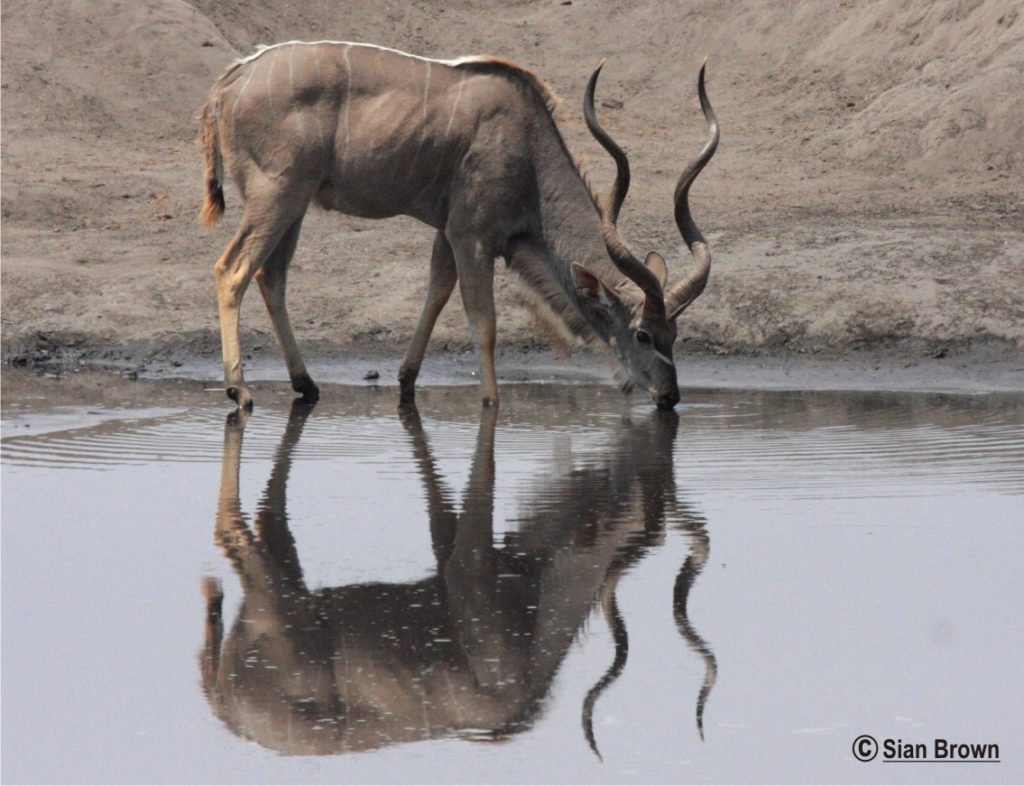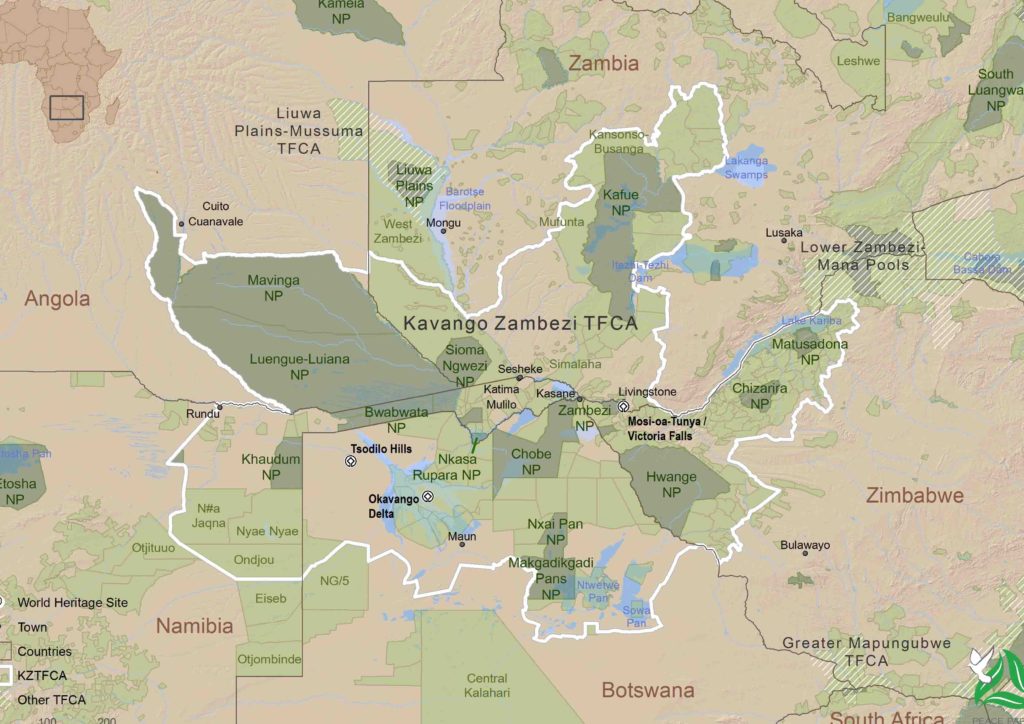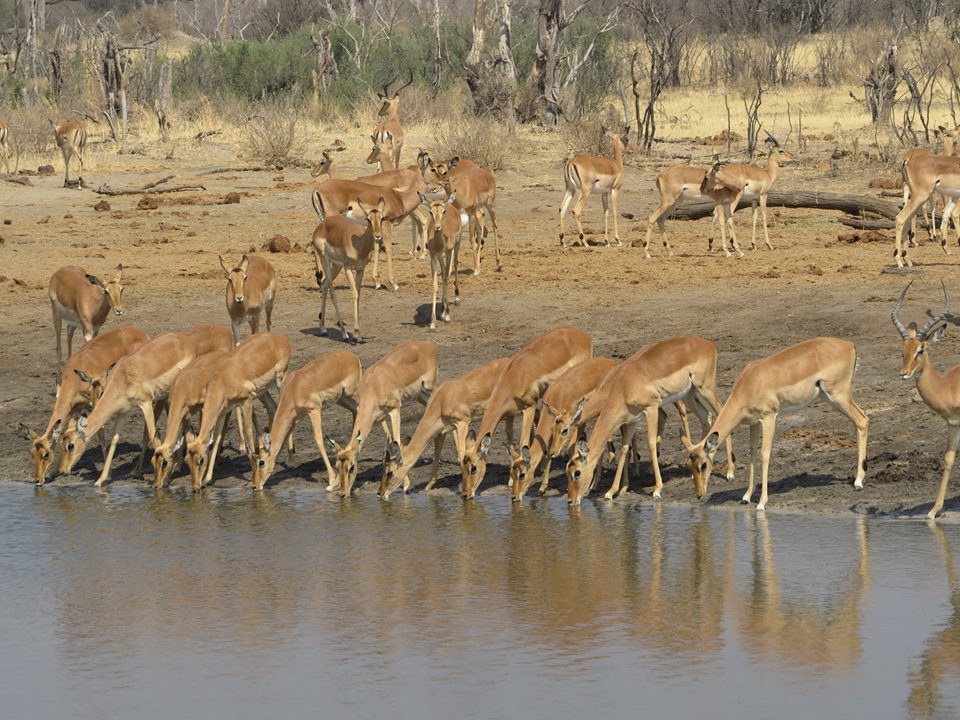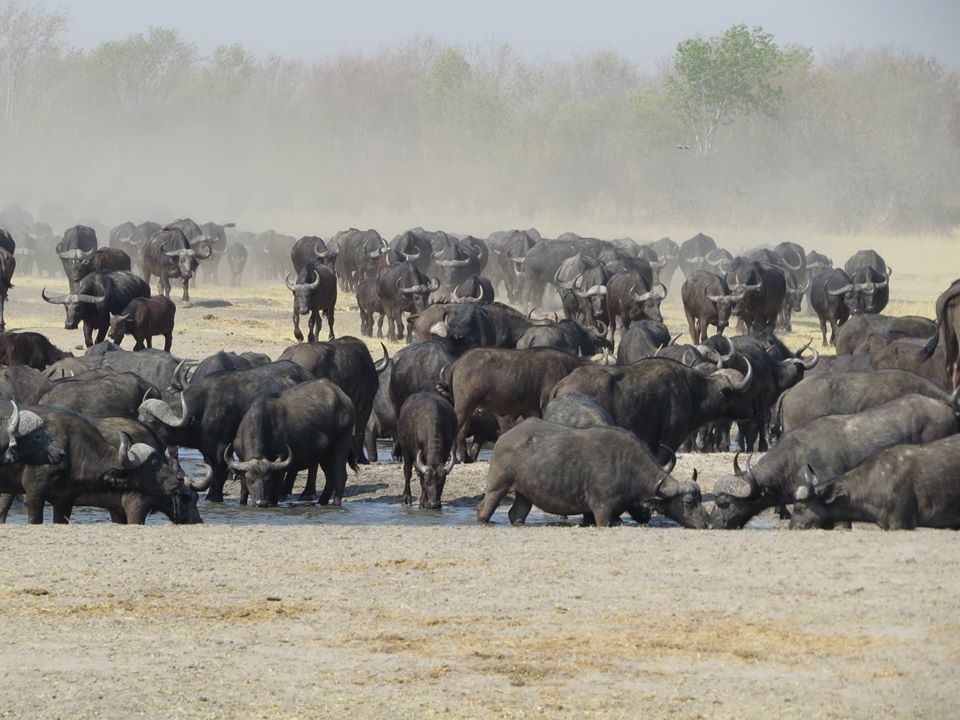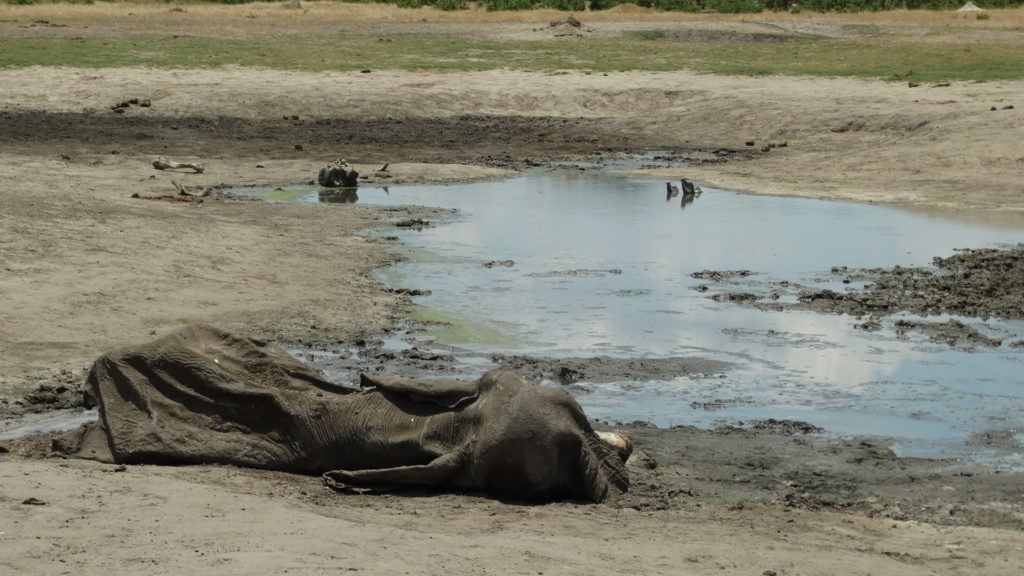An Overview by Dr Richard Hoare BVSc PhD
The formal protection of Hwange in Zimbabwe dates from 1928. At that time most game species were at low concentrations and elephants in particular were very rare. From the outset, however, the only permanent surface water within reach of the wildlife was situated outside Hwange National Park (HNP). In the ensuing decades as human settlement and development expanded around the north-east boundary of HNP, water-dependent wildlife species were destined to become progressively cut off from this source – the Gwayi River.
HNP is a large area (14 600 Km2) with an arid climate, receiving low and very variable rainfall. In the predominantly flat terrain with sandy soils, most rain water quickly drains into the ground and so cannot be naturally or artificially captured in large volumes. There are only three very small, seasonal rivers within the HNP boundaries, situated in one corner of the park. So the first park warden, Ted Davison, started experimenting with a programme of water supplementation from boreholes, as early as 1935. This was expanded over many years to provide supplementary water to an area of 40 – 50 % of the park where tourism development became established. 50 – 60% of the park was and still is left in a completely natural state where the only surface water collects in small natural waterholes or ‘pans’.
Natural pans are ephemeral and do not last the long dry season of six months or more. Water provision allowed elephants to become dry season residents in HNP and from the initial small numbers the population grew steadily to become the defining species of Hwange. After many years managers became worried about effects of large numbers of elephants on the habitat and thus also on other species. From 1966 to 1986 numbers were reduced through a programme of culling – removal of a portion of the population. After two decades this was discontinued because of both public sentiment and lack of capacity, allowing elephant numbers to increase once again.
The north-western boundary of HNP (within Zimbabwe) and the western national boundary (with Botswana) has never been a barrier to any species. Research has shown that elephants move hundreds of kilometres away from Hwange in the wet season when natural rainfall releases them from dry season dependence on the park’s boreholes. Elephants in northern Botswana regularly move hundreds of kilometres across that country, also at times entering Zimbabwe. So the elephants of Hwange should not be viewed in isolation. They are part of the largest population in Africa, shared between five countries, where they do move freely over vast distances.

In the late dry season elephants place a huge demand on some of the smaller supplemented water supplies and at times have to take turns drinking from the water outlet, since they have finished the water available in the pan. But good distribution of water supplies and the currently improved reliability of pumps, can spread the load of
‘elephant pressure’ in these difficult conditions
National boundaries that so intensively govern human lives are meaningless to wild animals. In 2006 the largest ‘trans-frontier conservation area’ (TFCA) in Africa was formalised by the Southern African Development community (SADC) in an agreement between Angola, Botswana, Namibia, Zambia and Zimbabwe and called the Kavango-Zambezi (KAZA) TFCA (www.kavangozambezi.org). It has expanded to reach 520 000Km2 – an area equal to Germany and Austria combined (see map). KAZA is a mosaic of many land uses in a huge and varied landscape, predicated upon the artificial and problematic colonial boundaries of both national parks, other land uses and countries being considerably ‘softened’ in order to focus on natural resource conservation. With such unrestricted movement, Hwange can be regarded as one of the dry season ‘refuges’ for KAZA’s elephants. The provision of water and elephants’ effects on the Hwange environment are often criticized, but these are not even as severe as those seen in other localised ‘water refuges’ which are fully natural e.g. the Chobe and Linyanti riverine areas in Botswana. Landscapes and their wildlife are far from homogenous.
In 2020 southern Africa is suffering a second consecutive very severe drought. This means that some elephants and other species will die in the closing months of 2020. As is usual, very old and very young animals will likely be the main victims. Elephants require a lot of food and in drought years, vulnerable individuals often die more from insufficient natural, good quality food and the lack of energy to find it, than from shortage of water. But the problem will be transient and overall it can be said with certainty that these deaths will not affect the viability of Africa’s largest contiguous elephant population in the KAZA TFCA – estimated at around 200 000, constituting possibly 40% of the continent’s remaining elephants.
What is the future of water supplementation in Hwange? Initial investigations have provided some evidence that the recharge from rainfall may have been adequate to replace the groundwater extracted over the years. Ted Davison’s first borehole for instance, still provides the same daily water yield as it did 85 years ago. Conversion from diesel to solar driven pumps has hugely diminished the environmental footprint of ‘game water supply’ in HNP. And the nature of the underground water reserve in the geology of Kalahari sand is now being further investigated due to concerns about the possible effects of climate change.
Many people tend to have vocal opinions and strong prejudices when it comes to wildlife protection. In expressing these, Friends of Hwange Trust (FOH) and Bhejane Trust appeal to individuals and organisations to consider the massive complexities of the HNP situation. One needs to contemplate a unique combination of very diverse issues: the park’s history; the realities of chronically underfunded park management; concerns about animal welfare; economic and tourism interests in Zimbabwe and its neighbours; the livelihood difficulties of rural communities living around the park, and many more.
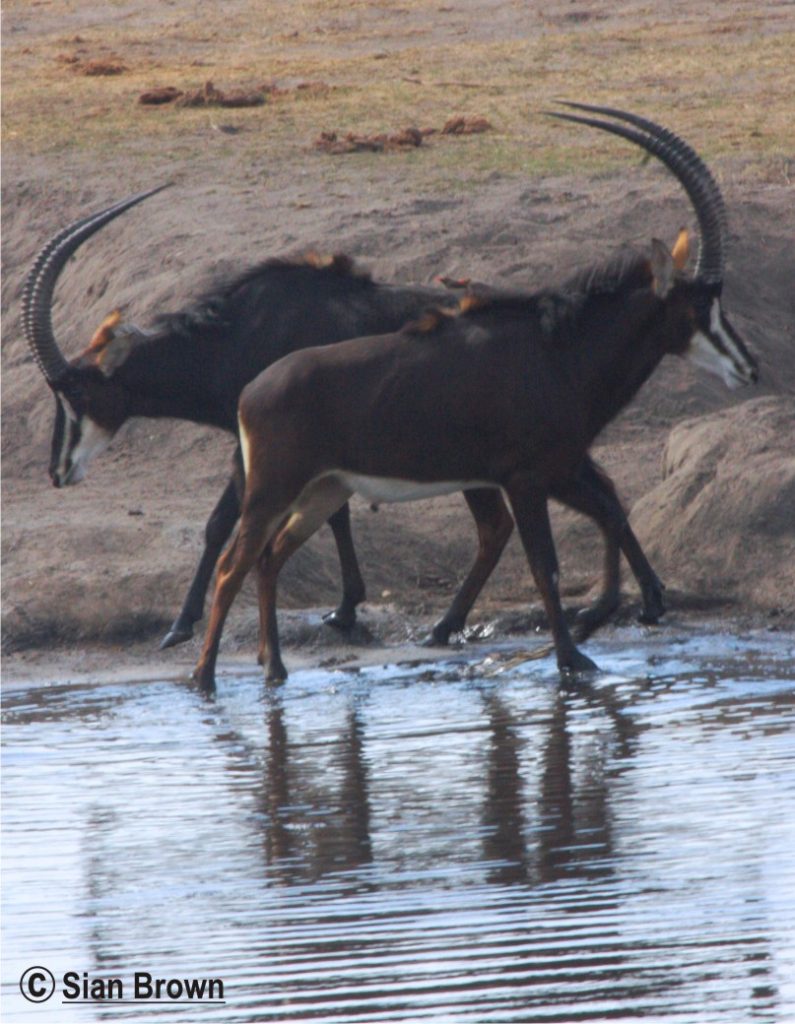
The current two year drought will very likely cause elephant mortality in Hwange very soon – and this is likely to be considerably higher than the recent, transient occurrence of elephant deaths in northern Botswana (around 330). Anyone with their country’s wildlife and national parks at heart, will want all those dedicated people already collaborating on the ground, to be able to continue to protect the incredible biodiversity of Hwange in times of natural crisis. There is detailed local knowledge and some capacity to deal with these situations. However, public and media opinion with strident and misinformed pronouncements, or sensational soundbites that can be very economical with the truth, (such as were frequently posted about this year’s elephant deaths in Botswana), will not be at all helpful. What will be helpful is a common sense, knowledge-based approach that considers both Hwange’s complex backstory and its current needs. The tendency for mere “armchair declarations” must be replaced by such understanding, which preferably then leads to actual assistance both in kind and financial – prioritised to where it is most needed.
In severe droughts elephants that have run out of energy due to lack of food often stay near water, where natural forage surrounding the pans is depleted. If they die there, this can give an erroneous impression to some people that elephants are dying from thirst and dehydration alone
FAQ’S ON ELEPHANTS AND WATER IN HNP.
Q: What is the natural water supply in HNP?
A: Natural rain-fed waterholes called ‘pans’. There are 3 very minor rivers in just one corner of HNP
Q: Why is water supplemented in a portion of HNP?
A: To maintain resident game populations for tourism in the dry season when natural water is very scarce
Q: When did water supplementation in HNP begin?
A: 1935. Natural pans do not last the 6 month dry season
Q: How is supplementary water delivered?
A: From boreholes now mostly powered by solar energy. Groundwater is pumped into some of the natural pans
Q: Are there no other sources of water?
A: A few shallow dams built on drainage lines, and a few natural springs with very low water yields
Q: How much of HNP receives supplementary water?
A: About 40% of the total area via about 100 boreholes. Water is supplied in the dry season when needed
Q: How much of HNP does not receive supplementary water?
A: About 60% of the total area. The “Wilderness Area” – with natural pans only
Q: How many elephants are there in HNP in the dry season?
A: Estimates are around 40 000 – 45 000. The last elephant census was done in 2014
Q: How many elephants are there in HNP in the wet season?
A: Unknown, but far fewer than in the dry season – a return to “ecological density” during the rainy season
Q: Why do these figures vary so much?
A: Because elephants disperse widely in the wet season. High elephant densities occur in the late dry season only
Q: How often do elephants drink?
A: All elephants have to drink within 3 days. Females with young drink more frequently
Q: Have elephants seriously damaged the vegetation in HNP?
A: Yes – around the larger supplemented water points, but the overall area damaged in HNP is small
Q: Do elephants exclude other species from water?
A: Credible research has shown this is not detrimental. If this was the case, other species would die out
Q: Why do some elephants die in droughts?
A: Often from lack of food more than lack of water. Droughts have not greatly reduced overall numbers
Q: Is there a policy to govern the water supplementation?
A: Yes – contained in a park management plan. The current officially approved plan is from 2015-2025
Q: Who pays for the water supplementation? A: The Wildlife Authority, NGO’s and tourism companies. Friends of Hwange Trust and Bhejane Trust are the lead organisations that oversee boreholes and water pumps in HNP. Both trusts are entirely reliant on fundraising and donations.
All Photo Credits Sian Brown
FOH works in close collaboration with Zimbabwe Parks and Wildlife Managment Authority (ZPWMA)
Friends of Hwange is committed to ensuring the future of Hwange National Park and its wildlife. Contributions are always most gratefully welcome.

